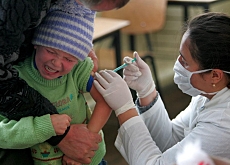How long can Tamiflu hold out against bird flu?

A Swiss study predicts that the deadly bird flu virus will develop resistance to new anti-viral drugs, if a pandemic breaks out.
The mathematical model used by researchers at Zurich’s Federal Institute of Technology (ETH) to plot the likely course of an outbreak showed that resistance is more likely if drugs are used as prophylactics.
The study, commissioned by the respected journal, Science, used data from previous influenza outbreaks combined with recent information about bird flu and the results of clinical trials on resistance to so-called neuraminidase inhibitor drugs such as Tamiflu, made by Switzerland’s Roche.
The model then calculated the likely consequences of a hypothetical bird flu outbreak in a school containing 500 people.
The programme was repeated to theorise how the virus would spread if the victims were only treated once they showed symptoms compared to people who had also taken drugs as a prophylactic.
The results showed that the virus displayed a greater resistance to Tamiflu when it had been used as a first line of defence as well as a treatment, according to study author professor Sebastian Bonhoeffer of ETH.
Resistance
“If you are going to use neuraminidase inhibitors such as Tamiflu as a prophylactic then, in my view, the inevitable consequence will be the likelihood of a faster emergence of resistance,” he said.
“Reviewing the [medical] literature we had the feeling that a considerable fraction of the medical community hoped that with neuraminidase inhibitors the situation would be different.”
But Bonhoeffer warned against using the results of the study to draw too many conclusions.
“This should not be interpreted that they should not be used as a prophylactic because they are the only first line of defence in the absence of a vaccine,” he said.
“By using neuraminidase inhibitors as a first line of defence, hopefully resistance will not happen too fast, buying enough time to develop a vaccine.”
Mutated
Bonhoeffer also conceded that it is so far unknown how effective mutated forms of the virus could be at transmitting from one person to another.
The World Health Organization played down the report, saying more research needs to be done to obtain a clear picture.
“This is a mathematical model that is not based on real life experience,” said spokeswoman Maria Cheng.
“We have never said Tamiflu is a silver bullet. We do not recommend its widespread use as past evidence shows that the general distribution of medicaments among populations increases the chance of resistance.”
swissinfo, Matthew Allen in Zurich
The Swiss government has ordered enough of the anti-viral drug Tamiflu for a quarter of the Swiss population.
To date, 204 human cases of bird flu infection have been reported to World Health Organization, with 113 proving to be fatal.
The virus was first confirmed in Switzerland in February, with 32 cases among wild birds to date. Nine cases of the deadly variant H5N1 have been confirmed.
Neuraminidase is a protein found on the surface membrane of the influenza virus.
It enables a replicate virus to bud from its host cell and for the virus to pass through mucus between cells in the human respiratory tract.
Neuraminidase inhibitors prevent the virus from replicating, therefore stopping the its spread.
The influenza virus has shown resistance against the M2 inhibitor, which is widely used across the globe.

In compliance with the JTI standards
More: SWI swissinfo.ch certified by the Journalism Trust Initiative




You can find an overview of ongoing debates with our journalists here . Please join us!
If you want to start a conversation about a topic raised in this article or want to report factual errors, email us at english@swissinfo.ch.